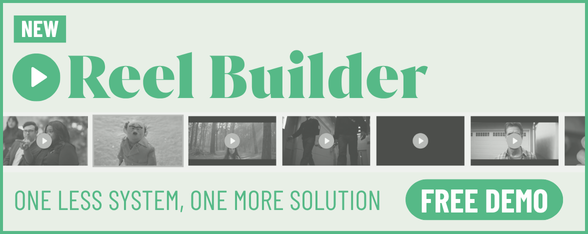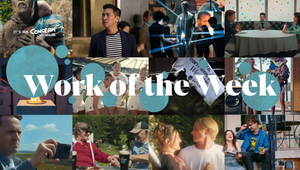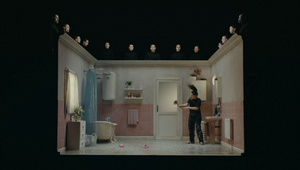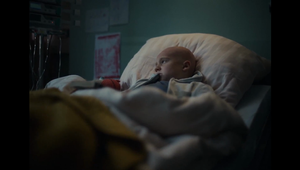
Supreme Music Asks Jonathan Deeb: And What About Music?

Kat Wyeth and Jonathan Deeb shared many collaborative years at BBDO Group—now they’re talking about music. They’ve created some incredible work together, now Kat’s curious to hear what Jonathan has to say about a passion that fuels so much of their creativity. In the “And what about music” series Supreme Music is shining a light on the musical backstories of their interview partners.
Q> Please tell us your name and what you do professionally.
Jonathan> Jonathan Deeb – chief creative officer at BBDO Germany.
Q> Can you tell us about your first truly memorable musical experience and how it impacted you. Why do you remember it so clearly?
Jonathan> Peter and The Wolf – was my first LP Vinyl. I was seven years old! The music made me so sad, and happy and scared all at the same time. I played it over and over and over…
Q> Give us an insight into the most memorable projects you executed musically and how?
Jonathan> We launched the “Share A Coke” names on cans in South Africa with a film about a dog in search of his name. The film was written with a specific track in mind. “That’s not my name” by the Ting Tings. The cast included a number of fashion, dance and photography collectives – and every scene was choreographed to punctuate at all the hit points. The track was blasted on every take on set during the filming… breathing energy into the performer’s actions. The film ended up going on to being one of South Africa’s most loved commercials ever and amongst the top performing films for Coca-Cola globally in 20 years and flighted in over 120 countries. Sometimes the visuals lead, and the sound follows, and sometimes it’s the other way around. In this instance, it was a very deliberate craft of the storyline, choreography and visual energy to be fully cohesive with an existing already famous music track.
In another altogether different project - DJ Lovre collaborated with the Porsche Formula E team to create a track built entirely from the raw audio elements of the electric race experience. The sounds include high-frequency whines of the electric motor, tire screeches, pit lane ambience, and even team radio chatter. The idea was to translate the energy and emotion of a Formula E race into a musical experience. The goal was to bridge the sensory gap between racetrack and dance floor, leading to a „sonic diary“. The track made it’s way beyond FE into the club scenes – connecting new audiences in an unexpected way.
Q> Did you, or do you play an instrument?
Jonathan> I spent my first holy communion money to buy a Piano. And began taking lessons with my Aunt who is a very talented blind musician and piano teacher.
The lessons sadly didn’t last as Karate training stole the focus. And I never learned to read sheet music. But my relationship with the piano played a pivotal role in my later teenage years. At a time that I was struggling with being a closeted gay teen at odds with my identity – I used the piano as a powerful outlet to release my emotions. I’d sit with my eyes closed, head against the piano and just let my fingers go with the flow. Some of the compositions that would come out would truly surprise me, some beautiful pieces, far beyond my technical skill. It didn’t feel like I was really playing – the music came from somewhere else – channeled perhaps. I would sometimes record these sessions, listening to them in the day. With great difficulty, I’d try to teach myself to learn to play what had come out so effortlessly before. The piano still connects with my soul, and have brought this into a number of projects I’ve worked on in the advertising space over the years. Learning to read sheet music is still on the to do list.
Q> What's the most unexpected place or situation where you've found inspiration for a music or sound approach?
Jonathan> I love Shazam… I suck the inspiration out of restaurant speakers… and weirdly even B grade sci fi series.
Q> What topics or movement in the world of music do you not like?
Jonathan> Fighting the algorithm. I love being exposed to new music in genres that are not my go to. But the algorithm thinks showing me what it knows I like will make me happy. So we battle.
Q> Can you tell us about your favorite recording or mix session?
Jonathan> Innecto Hair Colour – The lyrics of the track we composed captured a snapshot of the south Africa’s dark political history. When the artist nailed the take we all instantly knew was the one… there were tears in all our eyes. Tears because the track was beautiful and because the story was equally sad and empowering. It’s wonderful watching musicians in action – feels like witnessing a kind of magic.
Q> In what ways do you think AI is helping in your role and do you see any pitfalls?
Jonathan> AI is a great tool to put together approximations. Often in the past it was tough to get certain clients to understand the fusion of one genre with another – or a reorchestration of a specific sad song with an upbeat lyric / tempo. AI helps bring draft approximation of a unique creative vision to the table for quick consideration. This can be useful in selling in a topline vision. But it absolutely does not replace the need and magic that composers bring to the party.
Q> What should we have asked you that we didn’t ask?
Jonathan> Which holds the greater power… sound or sight! I couldn’t choose.















